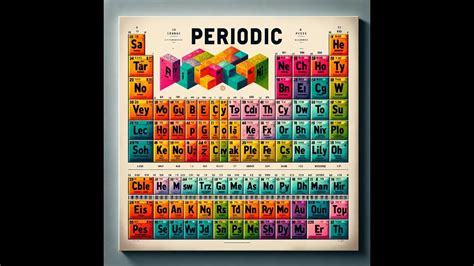The periodic table is a powerful tool that scientists use to organize and understand the elements. It provides a wealth of information about each element, including its atomic number, atomic mass, electron configuration, and chemical properties. However, the traditional periodic table can be difficult for students to understand because of the complex information it contains.

A colored periodic table is a modified version of the traditional periodic table that uses colors to represent different chemical properties. This makes it easier for students to visualize and understand the relationships between elements and their properties.
How to Use a Colored Periodic Table
A colored periodic table is easy to use. Simply find the element you are interested in and look at the color of its box. The color of the box will tell you what chemical properties the element has.
For example, all of the alkali metals are colored blue. This means that all alkali metals have similar chemical properties, such as being highly reactive and easily losing electrons.
Key to the Colored Periodic Table
The key to the colored periodic table is as follows:
- Blue: Alkali metals
- Green: Alkaline earth metals
- Red: Transition metals
- Purple: Metalloids
- Orange: Nonmetals
- Yellow: Halogens
- Brown: Noble gases
Applications of a Colored Periodic Table
A colored periodic table can be used for a variety of applications, including:
- Teaching chemistry: A colored periodic table can make it easier for students to learn about the chemical properties of elements.
- Predicting chemical reactions: A colored periodic table can help you predict the products of a chemical reaction.
- Designing materials: A colored periodic table can help you design new materials with specific properties.
Conclusion
A colored periodic table is a powerful tool that can be used to understand and visualize the chemical properties of elements. It is a valuable resource for students, chemists, and anyone else who is interested in chemistry.
Additional Information
In addition to the key provided above, there are a few other things to keep in mind when using a colored periodic table:
- The colors of the boxes are not always consistent across different periodic tables. This is because there is no universal standard for the colors used.
- Some elements may have more than one color. This is because they have multiple chemical properties.
- The colors of the boxes can be used to create patterns and trends. These patterns and trends can help you to understand the relationships between elements and their properties.
FAQs
1. What is the most common element in the universe?
Hydrogen is the most common element in the universe. It makes up about 75% of the universe’s mass.
2. What is the heaviest element on the periodic table?
Oganesson is the heaviest element on the periodic table. It has an atomic number of 118.
3. What is the lightest element on the periodic table?
Hydrogen is the lightest element on the periodic table. It has an atomic number of 1.
4. What is the most reactive element on the periodic table?
Fluorine is the most reactive element on the periodic table. It has a high electronegativity, which means that it has a strong tendency to attract electrons.
5. What is the least reactive element on the periodic table?
Helium is the least reactive element on the periodic table. It has a low electronegativity, which means that it has a weak tendency to attract electrons.
6. What are the noble gases?
The noble gases are a group of elements that are located in Group 18 of the periodic table. They are helium, neon, argon, krypton, xenon, and radon. The noble gases are all non-reactive gases.
7. What are the metalloids?
The metalloids are a group of elements that are located between the metals and the nonmetals on the periodic table. They have properties that are similar to both metals and nonmetals. The metalloids are boron, silicon, germanium, arsenic, antimony, and tellurium.
8. What are the transition metals?
The transition metals are a group of elements that are located in the d-block of the periodic table. They are characterized by their ability to form multiple oxidation states. The transition metals are scandium, titanium, vanadium, chromium, manganese, iron, cobalt, nickel, copper, zinc, gallium, germanium, arsenic, selenium, bromine, and krypton.
